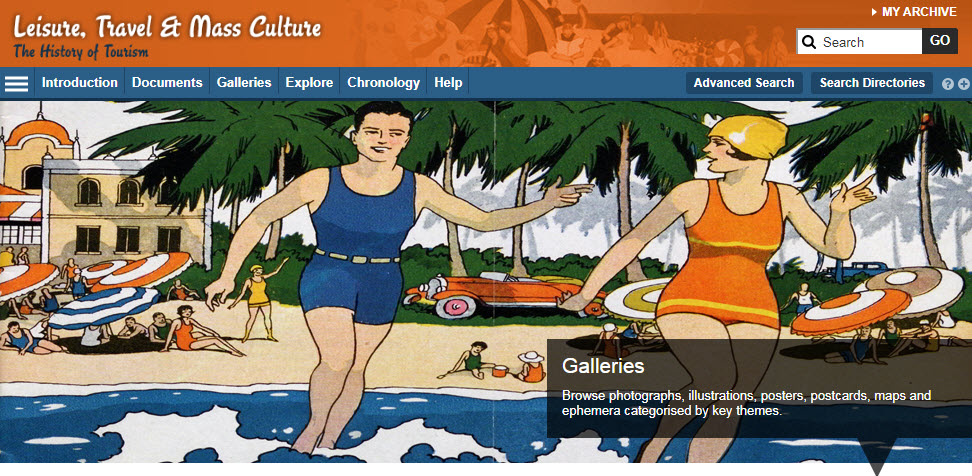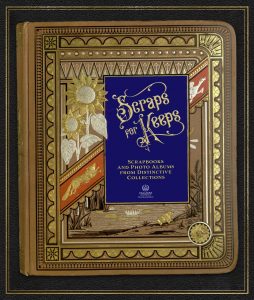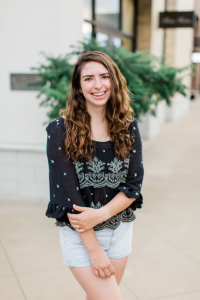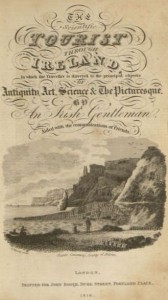By Susan Turkel
Stuck at home and feeling antsy? You’re not alone! Humans have experienced the travel bug for a long, long time. If you’d like to experience some armchair tourism, read on to learn about digitized collections that let us travel the world—and back into history—through the magic of library and archival collections!
Travel and tourism blossomed for Americans and Europeans during the 19th century, thanks to developments in technology and increasing prosperity for many people. The Villanova community now has access to an amazing set of primary resources that document this growth in tourism: the online collection Leisure, Travel and Mass Culture: The History of Tourism, produced by Adam Matthew Digital. This resource is linked from the Library’s Databases A-Z list.

Leisure, Travel, & Mass Culture: The History of Tourism (Adam Matthew Digital) splash page
This online collection is comprised of digitized guidebooks, brochures, leaflets, travel journals, maps, and promotional films sourced from a variety of libraries and archives in the US and UK. Key themes covered include accommodation, hospitality, and entertainment; the great outdoors; health and medical travel; historical, cultural, or religious travel; package tours, cruises, and organized travel; road, rail, and air travel; urban tours and city breaks; and women and tourism.
Inspired to dip a toe into this rich collection? Start with this online tour, and then read the essay Travel Chronicles: Tourism, Memory, and the Emergence of Modern America by Anthony Stanonis, PhD, lecturer in the School of History and Anthropology at Queen’s University, Belfast, written specifically to provide context for this resource.
The collection includes online exhibitions focusing on eyewitness travels (detailed, illustrated accounts of travel by seven different adventurers); a comparison between two iconic seaside resorts, Coney Island, N.Y., and Blackpool, England; and a detailed listing of tourism businesses and organizations that are mentioned throughout the resource.
You might also want to visit the image gallery which allows browsing and searching of photographs, illustrations, and maps, indexed by key themes. Another useful feature is the interactive world map, which allows you to find documents by clicking through locations on a spinning globe.
~ >|< ~
Can’t get enough of these historical travel materials? Falvey Memorial Library’s Special Collections holds a wide array of materials documenting travel and tourism, including hundreds of items that have been scanned and made available to the public via our Digital Library! Here are three online exhibits that feature such treasures.

Are We There Yet? exhibit sign
Are We There Yet? Travel, Tourism and Exploration is a digital exhibit that highlights many interesting items. This exhibit was co-curated by Kayla Van Osten (Digital Library Intern, Spring 2016) and Laura Bang (Distinctive Collections Librarian), with graphics by Joanne Quinn (Director of Communication and Marketing). It features narrative essays, images, and links to scanned documents on such diverse themes as modes of travel, guidebooks & travel narratives, around the world, religious travel, and imaginary travel.

Scraps for Keeps exhibit sign
You’ll also find travel memorabilia in our recent scrapbook exhibition, Scraps for Keeps: Scrapbooks and Photo Albums from Distinctive Collections, which was also curated by Laura Bang with graphics by Joanne Quinn. This exhibit includes scrapbooks and photo albums produced during the 19th and 20th centuries by people in the US and western Europe. The section on Travel & Tourism includes images of scrapbook pages highlighting postcards, photos, and colorful receipts collected during memorable trips. To find more scrapbooks that have been digitized by Falvey’s Special Collections team, try a keyword search in the Digital Library for scrapbook or album.
Finally, our digital exhibition Rambles, Sketches, Tours: Travellers & Tourism in Ireland, again curated by Laura Bang with graphics by Joanne Quinn, “highlights Irish travel narratives and related materials, primarily from the Joseph McGarrity Collection, in Falvey Memorial Library’s Special Collections. The site is broken into sections that highlight the methods of travel to and within Ireland, the motives of some of the most influential and popular writers, and the development of the tourism industry. In addition, there are five sections that look at some of the most popular travel destinations.”
In addition to these online exhibitions, you may wish to browse all of our Digital Library offerings with the subject label “Description and travel.” Highlights include a recently transcribed manuscript, Tour of Spain, 1896, in which the traveler provides a firsthand description of political unrest in Spain as well as observations about Spanish customs, architecture, and ancient Moorish ruins. This travel journal also includes hand-drawn route maps and ink sketches.
Enjoy your trip!
 Susan Turkel is a Social Sciences Librarian at Falvey Memorial Library. When this is all over, she hopes to travel to Italy.
Susan Turkel is a Social Sciences Librarian at Falvey Memorial Library. When this is all over, she hopes to travel to Italy.

 Jenna Newman is a graduate assistant in Falvey Memorial Library and a graduate student in the Communication Department. Current mood: Not ready to virtually travel to work today.
Jenna Newman is a graduate assistant in Falvey Memorial Library and a graduate student in the Communication Department. Current mood: Not ready to virtually travel to work today.


 Susan Turkel is a Social Sciences Librarian at Falvey Memorial Library. When this is all over, she hopes to travel to Italy.
Susan Turkel is a Social Sciences Librarian at Falvey Memorial Library. When this is all over, she hopes to travel to Italy.









































